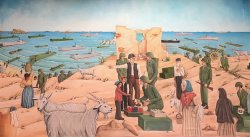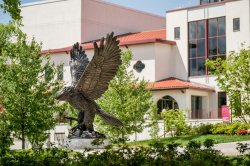Food, Hunger, Migration and the American Myth in Sicily at the Time of the Allied Landing: Completion of Phase 1 of Cali Research Project
Posted in: Endowed Chair's Research, Inserra, Inserra Chair News and Announcements, Italian News and Events, Uncategorized, World Languages and Cultures

Phase 1 of “Food, Hunger, Migration, and the American Myth in Sicily at the the Time of the Allied Landing,” a research project sponsored by the Angelo and Marie Cali Fund for Italian Studies with matching funds from the Inserra Chair Endowment was completed by Dr. Teresa Fiore (Inserra Chair in Italian and Italian American Studies, MLL Dept.) and her assistant Kenneth Browne (Italian Teaching Certificate candidate at MSU) during the Summer of 2018 on the occasion of the 75th Anniversary of the Allied Landing in Sicily.
What did Sicilians eat during the last part of Fascism during WWII, and what did the Allies bring to their diet? Was locals’ access to food extremely challenging across the board or did the anti-Fascist narrative of a deprived Sicily (and Italy by extension) serve the interest of the Allied landing in 1943 with its distribution of packaged and canned foods? Finally, was the perceived and self-perceived condition of destitution a reflection of an exaggerated image of the U.S. as the Land of Abundance that decades of migration from Italy had already created in the minds of the locals?
These are the questions tackled by this in-progress research project about food practices, military operations, and human mobility in Sicily before and after 1943, in part inspired by Leonardo Sciascia’s brilliant novella “The American Aunt” (1958). The project has entailed video-interviews with ten 90-to-100 year-old residents of Valledolmo, Licata, Gela and Agrigento, who have direct memories of that period, as well as local historians who have published on the subject. The interviews have so far revealed very different perspectives and experiences about food consumption and reaction to the arrival of the Allies and their foods, based on the local residents’ different socio-economic backgrounds, political leanings, and geographical locations, somewhat confirming Sciascia’s adage about truth being always the result of many truths.
Image credit: Antonino Mazzerbo, painter of “Lo sbarco alleato a Licata” (The Allied landing in Licata, 2016).
